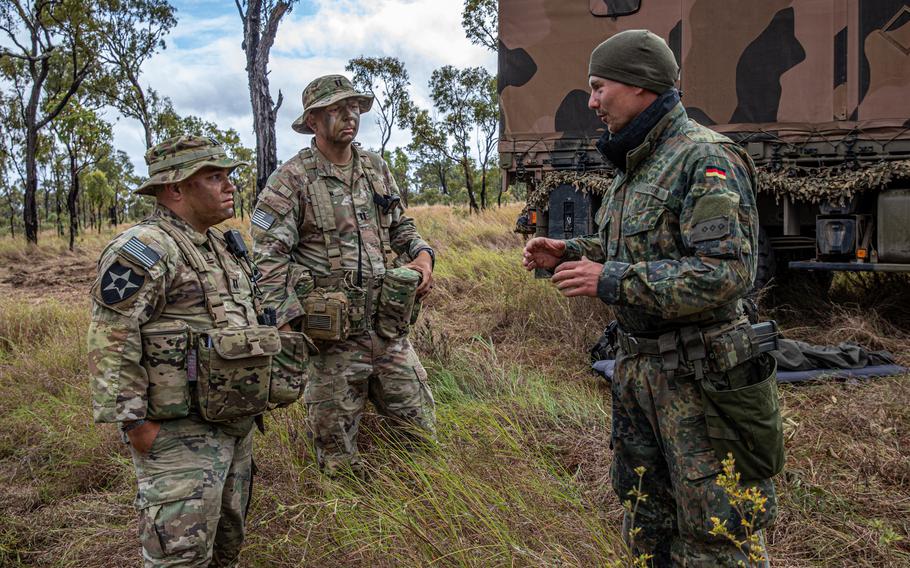
Army soldiers coaching at the Talisman Saber 23 exercise talk with a German soldier at the tactical operations center on July 26, 2023, during the Joint Pacific Multinational Readiness Center rotation at Townsville Field Training Area in Australia. Talisman Sabre is the largest bilateral military exercise between Australia and the United States advancing a free and open Indo-Pacific by strengthening relationships and interoperability among key allies. (Mariah Aguilar/U.S. Army)
WASHINGTON — Improving poor living conditions for soldiers and military families, overcoming a sag in recruiting, a pay increase for military personnel and investing in the Indo-Pacific region to challenge China are focuses in the Army’s proposed budget for fiscal 2025.
The proposed budget of $185.9 billion, a 0.2% increase from last year, comes as the Defense Department continues operating under short-term spending bills as Congress continues to wrangle over spending for fiscal 2024, which started Oct. 1. The Pentagon’s overall proposed budget for 2025 is $849.8 billion.
The budget includes $935 million for nine new barracks projects, more than three times last year’s budget request of nearly $288 million.
The military services have come under scrutiny from lawmakers and others to help improve the poor living conditions for service members and military families so troops can focus on warfighting.
Housing projects for active-duty troops are scheduled at Fort Johnson, La.; Fort Leonard Wood, Mo.; Joint Base Lewis-McChord, Wash.; Joint Base Myers-Henderson Hall, Va.; Smith Barracks in Baumholder, Germany; and Barton Barracks in Ansbach, Germany, according to Maj. Gen. Mark Bennett, director of the Army budget with the service’s assistant secretary for financial management and comptroller. There are two Reserve projects also planned, one at Parks Reserve Air Forces training area in California and another at Fort Buchanan, Puerto Rico.
Barracks sustainment is also funded to 100% for the first time in recent history at $680 million, Undersecretary of the Army Gabe Camarillo told reporters at the Pentagon.
The Army also provides a 4.5% basic pay increase, 3.9% basic allowance for housing increase and 3.4% basic allowance for subsistence increase.
After the service missed out on its recruiting goals for two consecutive years, it remains a key focus for the Army.
“It’s not borne by the Army alone. All the military services are facing some significant multiyear-recruiting headwinds,” Camarillo said. “We’ve been taking this challenge head on.”
The Army projects an end-strength of about 442,300 active-duty soldiers, 325,000 National Guard members and 175,800 reservists by the end of fiscal 2025, he said.
The service implemented a series of new recruiting jobs styled after talent-acquisition models used by private businesses.
The Army opened jobs on Jan. 3 for sergeants through master sergeants and warrant officers 1 through chief warrant officers 3 to become full-time talent acquisition technicians, or 420T. The position will work to standardize operations and advise staff on recruiting, retention, operations, marketing and analytics, according to the Army.
Service officials had previously said the recruiting goal for 2024 year is 55,000 new troops. Gen. Randy George, the Army chief of staff, recently said the service is ahead of where it was last year.
The service proposed budget allots $1.1 billion for marketing and advertising, an increase of 10% from 2024, Camarillo said. While the Army will continue to make investments in national advertisements, the service will look to invest in local and regional marketing campaigns.
He did point out that working under a stopgap spending measure, also known as a continuing resolution, is a problem.
“I’ll tell you one thing that we certainly found that doesn’t work. It’s being in a CR environment where we can’t really plan some of the media buys early enough in the year has been a real challenge for us because it forces us to buy inefficiently,” Camarillo said.
The war in Ukraine and China, which is viewed by defense officials as the top pacing challenge for the U.S. military, also remain areas of focus for the Army. Camarillo said the service alternated in recent years between funds for Europe and the Pacific. Since fiscal 2024, they are no longer doing that.
The Army’s budget request includes $1.5 billion for the Pacific Deterrence Initiative, a program designed to develop advanced capabilities, new operational concepts and build a more resilient force posture in the Indo-Pacific. The service also requested more than $461 million for Operation Pathways for 11 exercises in the Pacific, a 200% increase from last year.
Similar to the Pacific deterrence, the Army includes an allotment of $2.1 billion for the European Deterrence Initiative. This initiative looks to build up a deterrent in the face of Russian aggression, while funding the Army’s posture in the region and enabling rapid force buildup.
“There is a determined push to ensure that we are funding exercises as part of our NATO assurance mission in Europe, but also significantly investing in Pacific pathways,” the undersecretary said. “All of those nations in the Pacific, they all have armies, and they appreciate the opportunity to train with us.”
Here are some Army priorities from the service’s budget request for fiscal 2025:
$70.7 billion in military personnel funding to account for increases in basic pay, housing and subsistence.
$675 million for enlistment across the active-duty, Reserve and National Guard.
$14.1 billion for research, development, test and evaluation, or RDT&E.
$24.4 billion in procurement for ammunition, weapons and tracked combat vehicles, aircraft and missiles.
$4.5 billion in shifts of funding for the aviation rebalance strategy. This includes upgrades of $465 million for CH-47 Block II helicopters and $25 million for UH-60 Black Hawk helicopters.
$447 million for drones.
$625.6 million in NATO support.